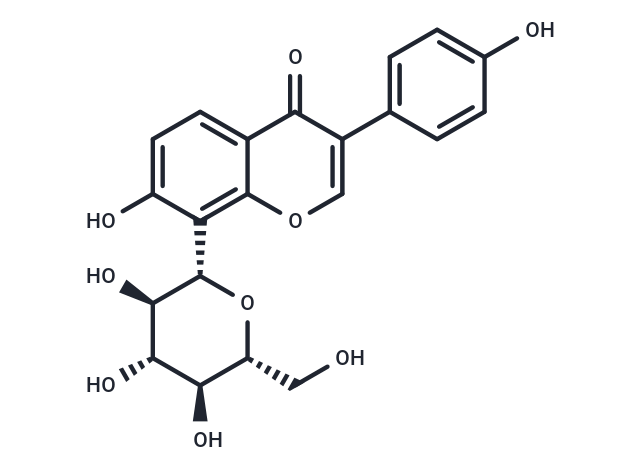Shopping Cart
Remove All Your shopping cart is currently empty
Your shopping cart is currently empty
Puerarin (Kakonein), also known as Kakonein, is a member of the class of compounds known as isoflavonoid C-glycosides. It is a 5-HT2C receptor antagonist.

| Pack Size | Price | USA Warehouse | Global Warehouse | Quantity |
|---|---|---|---|---|
| 5 mg | $47 | In Stock | In Stock | |
| 10 mg | $80 | In Stock | In Stock | |
| 25 mg | $163 | In Stock | In Stock | |
| 50 mg | $247 | In Stock | In Stock | |
| 100 mg | $372 | In Stock | In Stock | |
| 500 mg | $869 | In Stock | In Stock | |
| 1 mL x 10 mM (in DMSO) | $89 | In Stock | In Stock |
| Description | Puerarin (Kakonein), also known as Kakonein, is a member of the class of compounds known as isoflavonoid C-glycosides. It is a 5-HT2C receptor antagonist. |
| In vitro | Administering 300 mg/kg of Puerarin daily through oral ingestion to rats on a high-cholesterol diet significantly reduces the increase in total cholesterol levels in both serum and liver caused by the high-cholesterol diet. |
| In vivo | Puerarin, at a dose of 25 μM, induces dose-dependent growth inhibition in HT-29 cells. This effect is accompanied by an increase in bax and a decrease in c-myc and bcl-2. |
| Kinase Assay | STAT3-dependent dual-luciferase assay: HCT-116 cells are transiently transfected with reporter plasmid having the STAT3-binding element for regulating luciferase assay. Cells are treated with Cryptotanshinone for 24 hours at a concentration range of 0.2 to 50 μM. After treatment, cells are harvested in 20 μL of passive lysis buffer and luciferase activity is evaluated by the Dual Luciferase Reporter Assay kit on Wallac Victor2. The concentration of Cryptotanshinone that inhibits the luciferase activity by 50% represents IC50 value. |
| Cell Research | RAW264.7 cells are maintained at subconfluence in 95% air and 5% CO2 humidified atmosphere maintained at 37°C. The medium used for routine subculture is Dulbecco's Modified Eagle's Medium supplemented with 10% fetal bovine serum, penicillin (100 units/mL) and streptomycin (100 μg/ mL). An MTT assay is used to measure the viability of the cells after treatment with puerarin. After the supernatants are removed for nitrite determination, cells are incubated at 37°C with MTT (0.05 mg/mL) for 4 h, and the optical density is measured at 540 nm. The concentrations of puerarin are10, 20, 40 and 100 μM[1]. |
| Synonyms | Kakonein |
| Molecular Weight | 416.38 |
| Formula | C21H20O9 |
| Cas No. | 3681-99-0 |
| Smiles | OC=1C(=C2C(C(=O)C(=CO2)C3=CC=C(O)C=C3)=CC1)[C@@H]4O[C@H](CO)[C@@H](O)[C@H](O)[C@H]4O |
| Relative Density. | 1.642 g/cm3 |
| Storage | Powder: -20°C for 3 years | In solvent: -80°C for 1 year | Shipping with blue ice/Shipping at ambient temperature. | |||||||||||||||||||||||||||||||||||
| Solubility Information | DMSO: 250 mg/mL (600.41 mM), Sonication is recommended. Ethanol: < 1 mg/mL (insoluble or slightly soluble) H2O: < 1 mg/mL (insoluble or slightly soluble) | |||||||||||||||||||||||||||||||||||
| In Vivo Formulation | 10% DMSO+40% PEG300+5% Tween 80+45% Saline: 5 mg/mL (12.01 mM), Sonication is recommended. Please add the solvents sequentially, clarifying the solution as much as possible before adding the next one. Dissolve by heating and/or sonication if necessary. Working solution is recommended to be prepared and used immediately. The formulation provided above is for reference purposes only. In vivo formulations may vary and should be modified based on specific experimental conditions. | |||||||||||||||||||||||||||||||||||
Solution Preparation Table | ||||||||||||||||||||||||||||||||||||
DMSO
| ||||||||||||||||||||||||||||||||||||
| Size | Quantity | Unit Price | Amount | Operation |
|---|

Copyright © 2015-2025 TargetMol Chemicals Inc. All Rights Reserved.